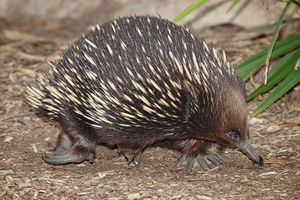Monotremes: Monotremata
Physical Characteristics

"Monotreme" means "one opening" and refers to the single rear orifice, or opening, that these animals have for getting rid of wastes, laying eggs, and mating. The lower intestine, excretory system (system that gets rid of wastes), and reproductive system all end at this opening, called the cloaca (kloh-AY-kah). This feature is common in reptiles and birds but extremely rare among mammals.
Trying to describe a "typical" monotreme (MAHN-ah-treem) is difficult, since the only two living types, the platypus and the echidna (ih-KID-nah), do not look much alike at first glance. The platypus is built in a streamlined manner, like an otter, has soft fur, and its snout resembles a duck's bill, while the echidna looks like a pudgy, waddling watermelon covered with fur and sharp spines, with a narrow, hornlike snout. Although echidnas may look overweight, most of the soft tissue mass that might be mistaken for blubber is muscle, lots of it. The platypus is semiaquatic, hunting animal food underwater but sheltering in a dry burrow, but the echidnas are land animals that forage, or search, in the soil for insects and worms.
Adult platypus are about the size of house cats, while echidnas range from twice to three times as large as a house cat. An adult platypus weighs from 3 to 5 pounds (1.4 to 2.3 kilograms), and its adult head and body length runs 12 to 18 inches (30 to 46 centimeters), the tail adding another 4 to 6 inches (10 to 15 centimeters). The short-beaked, or short-nosed, echidna can grow up to 14 pounds (6.4 kilograms), with a head and body length of up to 21 inches (53 centimeters), the stubby tail adding another 3 or 4 inches (7.6 to 10 centimeters). The long-beaked, or long-nosed, echidna weighs up to twenty pounds, with a head and body length ranging from 18 to 31 inches (45 to 77.5 centimeters), while the tail, like that of the short-nosed echidna, is a mere stubby shoot. Male platypus and male echidnas are larger than females.
Platypus and echidnas are often called "primitive" because they carry a number of reptilian, or reptile-like, characteristics along with typically mammalian features. Ever since the first discovery of monotremes by Europeans in the late 1700s, zoologists, scientists who study animals, have been busy studying this mix of details in order to place the monotremes properly in the framework of mammalian evolution. Even more confusing is that the living monotremes have a number of modified, or changed, features all their own, examples being the snouts of platypus and echidnas.
The most well-known and special feature of the monotremes, and the one that seems most reptilian, is that the females lay eggs rather than giving live birth. Monotremes are the only living, egg-laying mammals. Other characteristics that platypus and echidnas have in common are similar skeletons and highly modified snouts equipped with nerves whose endings are sensitive to pressure and to natural electricity. Monotremes have fur, but not whiskers, while the echidnas, in addition to fur, have sharp, defensive spines, which are modified hairs, scattered over their backs and sides.
Monotremes walk in a reptilian manner, like alligators and crocodiles. Like the arms of someone in the middle of doing a pushup, the upper bones of monotreme forelimbs and hindlimbs go straight out from the body, horizontal to the ground, and the lower limb bones go straight down. Other lines of mammal evolution have abandoned this clumsy sort of movement and now carry their entire legs vertically beneath their bodies. Zoologists are not yet sure if the push-up style of legs and walking in monotremes is something left over from their reptilian ancestors or if they are more recent changes to fit their lifestyles.
Another odd monotreme characteristic is that male and female platypus, and male echidnas, have short, sharp, hollow, defensive spurs on the inner sides of the ankles of their rear limbs. The spurs of the male platypus connect with poison glands and are fully functional as stingers.
Additional topics
Animal Life ResourceMammalsMonotremes: Monotremata - Physical Characteristics, Behavior And Reproduction, Monotremes And People, Conservation Status - GEOGRAPHIC RANGE, HABITAT, DIET